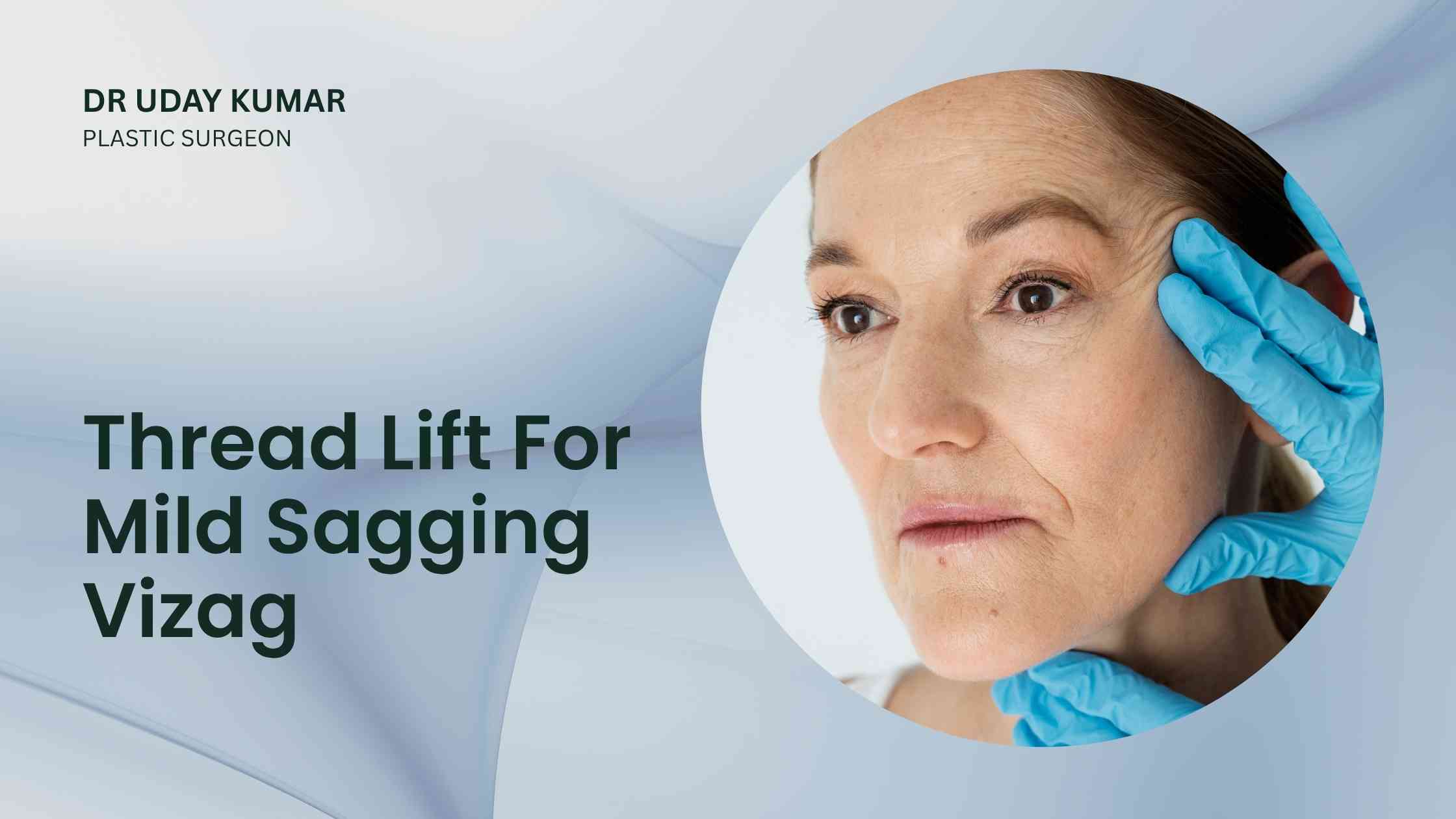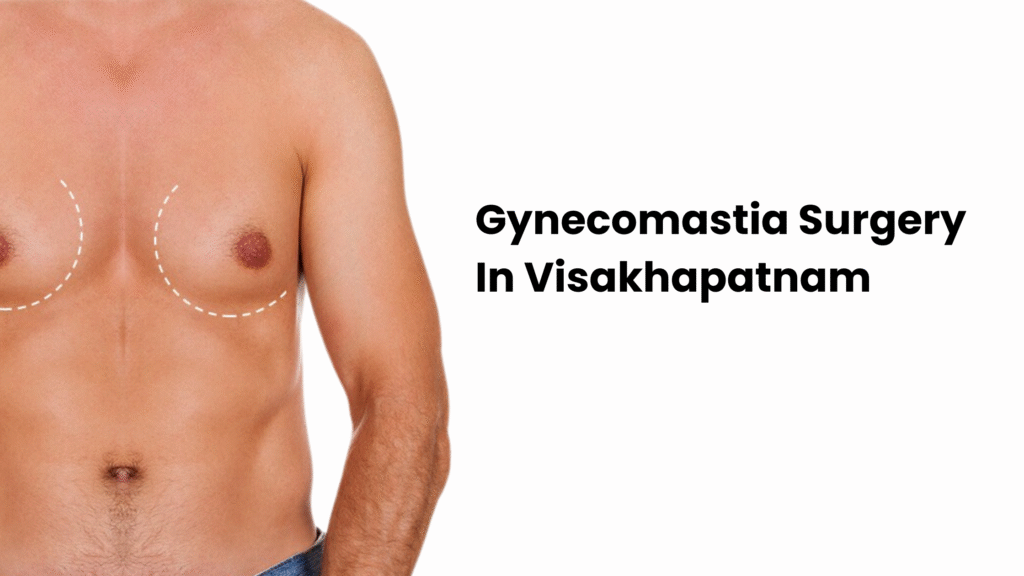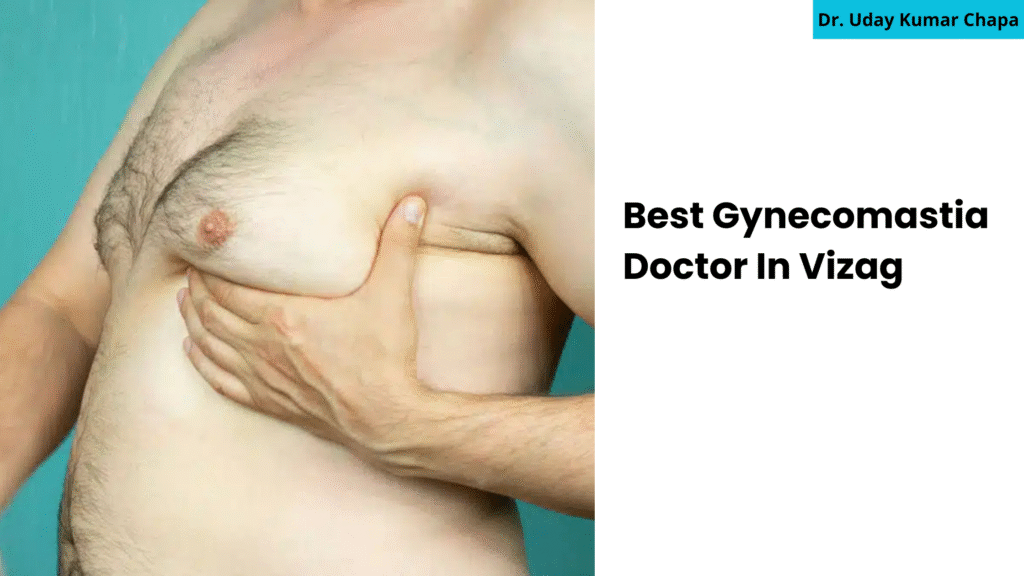
As the years pass, subtle changes in our skin and soft tissue can add up: the cheeks lose volume, the jawline softens, and gentle drooping around the mouth and neck can change the face’s youthful architecture. These early-to-moderate signs of aging are often described as mild sagging, and for many people they are the first visible reminder that skin elasticity and collagen are declining. Fortunately, modern aesthetic medicine offers a spectrum of approaches to correct these changes without the time, cost, and recovery of a conventional surgical facelift. A thread lift is a minimally invasive procedure that repositions and supports sagging tissues using fine, absorbable sutures placed beneath the skin. In Vizag, Dr. Uday Kumar has developed a patient-centered practice that focuses on natural-looking, conservative rejuvenation for men and women who want noticeable improvement with minimal downtime. This detailed guide explains what a thread lift is, who is a good candidate, how the treatment is performed at Dr. Uday Kumar’s clinic, the different thread types and techniques used, the typical recovery and results timeline, important pre- and post-care instructions, potential risks and how they are managed, and how thread lifts compare to other non-surgical and surgical options, so you can make an informed decision about your facial rejuvenation journey.
Why Choose Dr. Uday Kumar for Thread Lift in Vizag
Choosing the right doctor for a facial rejuvenation procedure matters as much as choosing the procedure itself, because subtle technical differences produce very different visual outcomes. Dr. Uday Kumar combines a deep understanding of facial anatomy with years of hands-on experience in aesthetic procedures, prioritizing proportion, symmetry, and preservation of a patient’s natural identity. Under his care, every thread lift begins with a thorough facial analysis: skin quality, fat distribution, bone structure, muscle tone, and the degree of skin laxity are all carefully evaluated to determine whether a thread lift alone will meet expectations or if a combined approach (for example, adding fillers, skin resurfacing, or neuromodulators) would produce a superior, longer-lasting outcome. Dr. Uday Kumar is known for conservative planning—he aims for enhancement rather than dramatic change—so results appear refreshed and natural rather than “pulled.” His clinic adheres to strict safety protocols, uses high-quality, approved thread materials, and employs aseptic technique and modern local anesthesia methods to ensure patient comfort. Many patients choose Dr. Uday Kumar because he explains alternatives clearly, sets realistic expectations, documents the planned vector and number of threads, and provides personalized post-procedure support to optimize healing and results. The combination of technical skill, aesthetic judgment, and patient-first communication distinguishes his practice in Vizag for those seeking thread lift solutions for mild sagging.
Services and Treatment Process
A thread lift is performed using dissolvable sutures—commonly PDO (polydioxanone), PLLA (poly-L-lactic acid), or PCL (polycaprolactone)—each with slightly different longevity and collagen-stimulating properties. At Dr. Uday Kumar’s clinic the treatment protocol begins with an in-depth consultation where photographs and markings are taken and a customized plan is created to target problem areas such as the mid-face, jowls, jawline, neck, or brows. On the day of treatment, topical and local anesthetic are applied so patients experience minimal discomfort. Using ultra-fine needles or cannulas, the selected threads are introduced under the skin along carefully chosen vectors that lift and reposition sagging tissues; some threads have microbarbs or cones that anchor to the subcutaneous tissue for immediate mechanical lift, while smooth or biostimulatory threads focus more on stimulating collagen over time. The procedure generally takes between 30 and 90 minutes depending on the areas treated and the number of threads used. There are variations in technique—such as “anchor” vs “mesh” patterns, lifting vs contouring placements, and combination protocols where threads are paired with hyaluronic acid fillers to restore volume while threads reposition tissue. After placement, minor trimming of thread ends and gentle molding of tissues ensure symmetrical and natural contours. Because the sutures are absorbable, they gradually dissolve while the newly formed collagen scaffold maintains skin support for months to years. Dr. Uday Kumar’s service package typically includes detailed pre-operative guidance (medication adjustments, avoiding blood thinners, smoking cessation advice), the procedure itself performed in a sterile minor-procedure suite, and scheduled follow-up visits to monitor healing and outcome, with additional touch-ups planned if necessary.
Benefits of Thread Lift Treatment
Thread lifts offer a balance between efficacy and minimal invasiveness, providing multiple benefits for the right candidate. One immediate advantage is the mechanical lift—patients often see a visible improvement in facial contour and definition right after the procedure. Beyond the immediate effect, threads act as a scaffold that stimulates neocollagenesis (new collagen formation), elastin production, and localized tissue remodeling, so skin quality and firmness continue to improve during the following three to six months. Because the technique avoids wide surgical incisions, thread lifts generally involve much shorter recovery—most patients resume normal activities within a few days, and bruising or swelling is usually mild and short-lived. The treatment can be precisely targeted to address isolated concerns such as early jowling, mild midface descent, or a sagging brow without altering other facial features. Another significant benefit is versatility: thread lifts can be combined with complementary non-surgical procedures such as dermal fillers to replace lost volume, botulinum toxin to relax dynamic lines, or laser and microneedling to improve surface texture—creating a multi-layered rejuvenation plan that addresses volume, lift, and skin quality. For patients seeking a step up from topical treatments and injectables but not ready for surgery, thread lifts provide a meaningful, measurable improvement with fewer risks and a quicker recovery than a full surgical facelift.
Expected Results, Longevity, Recovery and Safety
When performed for mild sagging by an experienced practitioner like Dr. Uday Kumar, a thread lift produces a natural-looking enhancement that can last from 12 to 36 months, depending on the thread material used, the patient’s age, skin quality, lifestyle factors, and whether adjunctive treatments are used. PDO threads often deliver good short- to mid-term lift and collagen stimulation, while PLLA and PCL threads can offer longer-lasting structural support due to their slower absorption and stronger stimulatory effect. The recovery timeline is typically brief: most patients experience light swelling and only minor bruising that resolves within 3–10 days, and discomfort is usually manageable with over-the-counter analgesics. Patients are advised to sleep elevated for a few nights, avoid strenuous exercise for about 1–2 weeks, refrain from facial massages or dental procedures that may disturb threads for a short period, and to follow sun-protection and skin care guidance to support healing. Safety is a paramount concern; common but minor side effects include transient numbness, mild asymmetry, or temporary puckering that usually resolves as swelling subsides. Serious complications—such as infection, thread migration, extrusion, or significant dimpling—are uncommon when proper technique, sterile conditions, and patient selection criteria are observed. Dr. Uday Kumar mitigates risks through careful pre-procedure screening, precise technique, and immediate access to follow-up care; any concerns during healing are assessed promptly to avoid complications and optimize outcomes.
Who Is an Ideal Candidate and Contraindications
The ideal candidate for a thread lift is someone with mild to moderate skin laxity who desires lifting and contouring but prefers to avoid general anesthesia and prolonged surgical recovery. Patients in their late 30s to early 60s often obtain the best balance of tissue response and natural restoration, especially when there is some remaining skin elasticity and not extensive excess skin. Patients with realistic expectations, good overall health, and commitment to postoperative instructions typically see the greatest satisfaction. Contraindications include active skin infections in the treatment area, uncontrolled systemic illnesses, bleeding disorders, pregnancy or breastfeeding, and unrealistic expectations or a desire for dramatic, long-lasting correction that only a surgical facelift can deliver. Smokers should be counseled about the detrimental effect of smoking on healing and collagen formation and advised to quit prior to treatment for optimal results.
Pre- and Post-Procedure Care and Practical Considerations
Before the procedure, patients are advised to avoid aspirin, NSAIDs, herbal supplements that increase bleeding risk, and excessive alcohol for several days. A pre-procedure photograph and mapping session helps document goals and allow for objective comparison after treatment. On the day of the thread lift, comfortable clothing and a light meal are recommended. Post-procedure, gentle cold compresses may reduce swelling and soreness; sleeping on your back with the head elevated for a few nights minimizes fluid accumulation. Facial movements should be minimized for the first few days—avoid wide yawning or chewing very hard foods—and makeup is usually restricted for 24–48 hours. Follow-up appointments help the clinician check for symmetry, address any mild irregularities, and advise on supplementary treatments to extend longevity such as skin tightening therapies or maintenance injectables. Financially, thread lifts can vary depending on the number of threads used and areas treated; Dr. Uday Kumar provides a transparent pricing structure at consultation and discusses whether a staged approach or combined treatments represent better value and results for your goals.
Conclusion
A thread lift for mild sagging is a sophisticated, minimally invasive tool in the modern aesthetic toolbox: it offers immediate contour improvement, gradual enhancement through collagen stimulation, and a rapid return to daily life when performed by a careful, anatomically-informed practitioner. In Vizag, Dr. Uday Kumar brings a thoughtful, individualized approach that emphasizes natural proportions, meticulous technique, and comprehensive patient education. If you are noticing early signs of facial laxity and are seeking a rejuvenation option that balances effectiveness with low downtime, a consultation with Dr. Uday Kumar can clarify whether a thread lift, possibly combined with complementary non-surgical treatments, is the ideal path to refreshed, natural-looking results. Your consultation will evaluate candidacy, recommend the appropriate thread type and placement strategy, and outline a tailored aftercare plan so you can make an informed decision and begin your journey toward restored facial harmony with confidence.
FAQ
How long do thread lift results last?
The longevity of a thread lift depends on the type of thread used and individual skin factors. PDO threads typically last between 12–18 months, while PLLA and PCL threads can last up to 2–3 years. Collagen stimulation continues even after the threads dissolve, helping to maintain firmness and lift for a longer period. For sustained results, Dr. Uday Kumar may recommend periodic maintenance sessions or combining thread lift with other non-surgical treatments like dermal fillers or skin tightening therapies.
Who is the ideal candidate for a thread lift?
The best candidates for a thread lift are men and women with mild to moderate skin laxity—those noticing early signs of sagging but not yet requiring a surgical facelift. Typically, individuals in their 30s to 60s with relatively good skin tone and realistic expectations achieve the best outcomes. If you have minimal loose skin and want a refreshed, natural look without surgery or significant downtime, a thread lift by Dr. Uday Kumar in Vizag is an excellent option.
Is the procedure painful?
Most patients experience minimal discomfort during a thread lift. A local anesthetic or numbing cream is applied to ensure the area is completely comfortable. Patients may feel slight pressure or a gentle tugging sensation as the threads are positioned, but the procedure is generally well-tolerated. After treatment, mild tenderness or tightness may persist for a few days, which subsides naturally.
How long does recovery take after a thread lift?
Recovery after a thread lift is quick compared to surgical alternatives. Mild swelling, bruising, or tightness may appear initially but usually resolves within a few days. Most people return to normal activities within 24–48 hours. Dr. Uday Kumar provides detailed aftercare instructions—such as avoiding facial massages, strenuous exercise, or exaggerated facial movements for about a week—to ensure optimal healing and results.
What areas can be treated with a thread lift?
Thread lifts are versatile and can target multiple areas of the face and neck. Commonly treated areas include the cheeks, jawline, jowls, nasolabial folds, neck, and even the brows for a subtle “fox-eye” or brow lift effect. Dr. Uday Kumar customizes the thread pattern and depth based on each patient’s unique facial structure to ensure a balanced, natural lift that enhances overall facial harmony.
Are the results natural-looking?
Lorem ipsum dolor sit amet, Yes, when performed by an experienced aesthetic practitioner like Dr. Uday Kumar, thread lift results look subtle, balanced, and natural. The goal is to refresh your appearance without making you look “done” or over-pulled. Over the following weeks, as collagen builds and the skin adapts to its new position, results become even smoother and more refined.
Are there any risks or side effects?
Thread lifts are considered very safe when performed by qualified professionals. Minor side effects such as temporary bruising, swelling, or mild skin dimpling are normal and resolve quickly. Rarely, thread migration or infection can occur, but these are minimized through sterile techniques and proper aftercare. Dr. Uday Kumar uses high-quality threads and precise placement methods to ensure the safest and most effective results for every patient.
Can thread lift be combined with other treatments?
Absolutely. Many patients choose to combine their thread lift with complementary procedures for enhanced rejuvenation. Dermal fillers can be used to restore lost facial volume, while laser treatments or chemical peels improve skin texture and tone. Combining these treatments under Dr. Uday Kumar’s guidance can produce comprehensive, long-lasting results without surgery.



